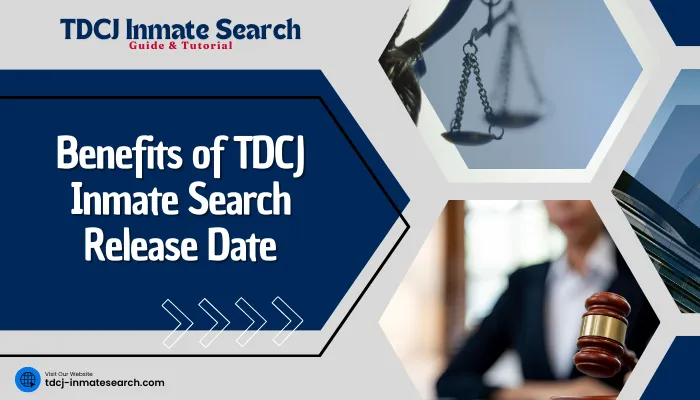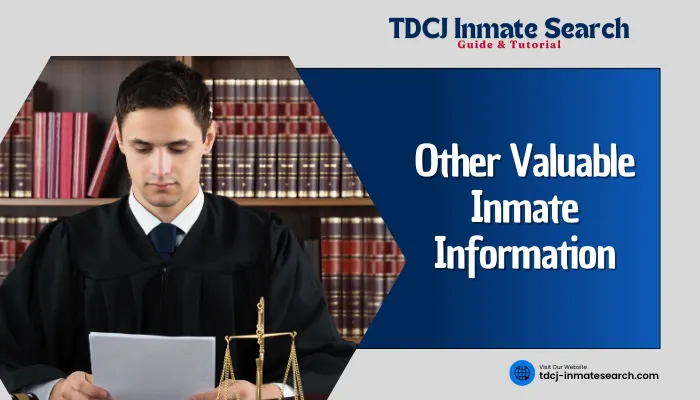Knowing when a loved one might be coming home from a Texas Department of Criminal Justice (TDCJ) facility is, you know, a very important piece of information for many families. It helps with planning, with preparing for that big transition, and just generally provides a sense of peace. For anyone trying to figure out how to get this specific detail, the TDCJ offers tools online to help you look up inmate information, including those crucial release dates. It's really about giving people a way to stay informed, and that's pretty much what this guide is for.
The first few weeks after someone leaves prison can be, in a way, quite challenging. There are lots of things to think about, and even for someone who feels ready, it can be a stressful time. Having a clear idea of when that day might arrive can make a significant difference. So, if you're looking for details like where an inmate is located, what their offenses were, or specifically when they might be released, the official site of the Texas Department of Criminal Justice has resources for you.
This guide aims to make that search a bit simpler, breaking down how you can use the TDCJ inmate search to find the release date you need. We'll talk about what information you might want to have ready and what to expect when you look things up. It's all about helping you connect with the details that matter most, actually.
Table of Contents
- Understanding the TDCJ Inmate Search
- What You Need to Start Your Search
- How to Find the Release Date and Other Details
- Important Things to Know About Release Dates
- Support After Release
- Frequently Asked Questions
Understanding the TDCJ Inmate Search
The Texas Department of Criminal Justice provides an online tool that allows people to search for offender information. This tool is, you know, a key resource for families and others who need to keep up with someone incarcerated within the Texas system. It's designed to be straightforward, giving you access to important facts about inmates in their facilities. This includes things like their current location, what they were charged with, and, very importantly, their potential release dates. It's pretty much a direct way to get official information, which is something many people really appreciate.
When you use the Texas Department of Criminal Justice inmate search, you are looking at data that helps you track an individual. This system is part of the larger oversight provided by the Texas Board of Criminal Justice, which also handles different divisions and departments. So, in a way, this search function is part of a much bigger structure that manages correctional, administrative, and other related services. It’s actually quite a comprehensive system, offering a lot of details if you know where to look.
The goal of this search function is to offer transparency and access to public information. It’s not just about finding a name; it’s about getting specific details that can help you understand an inmate's situation. For instance, you can find out about their unit assignment, which might be somewhere like the Memorial Unit in Rosharon, a facility that has been around for a very long time, since 1917, and has seen many changes. Or, it could be the Hobby Unit in Marlin, located at 742 FM 712. Knowing the unit can be really helpful for planning visits or sending mail, too.
What You Need to Start Your Search
When you decide to use the Texas Department of Criminal Justice inmate search online, it’s helpful to have some specific pieces of information ready. The system asks you to specify one or more fields to help narrow down your search. This makes it much easier to find the exact person you are looking for, especially since many people can have similar names. So, having a little bit of detail upfront can save you some time and effort, you know.
You can search for an offender by providing a name, which is probably the most common way people start. However, if you have a State Identification (SID) number or a current TDCJ number, those can make your search even more precise. It’s like having a unique identifier that points directly to the person you are interested in. If you happen to have a previous TDCJ number, there’s usually an option to click a button to help you with that, too, which is quite handy.
Having at least one of these identifiers makes the search much more effective. If you only have a name, you might get a list of several individuals, and then you’ll need to look through them to find the right one. But with a number, it's typically a direct hit. It's just a little bit of preparation that can make a big difference in how quickly you find what you are looking for, actually.
Searching by Name
When you search by name, you typically enter the first and last name of the person you are trying to find. It’s often best to enter as much of the name as you know to get the most accurate results. For example, if you know a middle initial or a full middle name, adding that can help refine the search. This is particularly useful if the person has a very common name, like John Smith, where there might be many entries. So, providing more detail here is usually a good idea.
The system will then usually show you a list of individuals whose names match your input. From this list, you can look for other identifying factors, such as their birthdate or the county they were sentenced in, to make sure you have the right person. This step is pretty important because you want to be certain you are looking at the correct individual's information before moving forward. It’s about being careful and accurate with your search, you know.
Once you locate the correct person on the list, there will typically be a "view details" link. Clicking on this link will take you to a page with more comprehensive information about that specific individual. This is where you will likely find the release date, along with other important facts. It's the next step in getting all the details you need, so, you know, it’s a critical click.
Using SID or TDCJ Number
If you have an SID number or a current TDCJ number, your search becomes much more straightforward. These numbers are unique identifiers assigned to individuals within the criminal justice system. Think of them like a personal identification number for an inmate. When you use one of these, the system can usually pull up the exact record you need without having to sift through multiple names. It’s a very direct way to access information, actually.
The SID number, or State Identification Number, is often used across different parts of the state's justice system. The TDCJ number is specific to the Texas Department of Criminal Justice. Both are highly effective for pinpointing a particular inmate's record. If you happen to have one of these, you're pretty much set for a quick and accurate search. It really streamlines the whole process, you know.
For those who might have an older, or "previous," TDCJ number, the search portal often has a specific option to help you with that. This shows that the system is designed to accommodate different types of historical information, which is quite thoughtful. It means that even if the inmate's identification number has changed over time, you can still use older records to find them. This flexibility is a very helpful feature for many users.
How to Find the Release Date and Other Details
Once you've entered your search criteria, whether it's a name, SID, or TDCJ number, and you've identified the correct individual from the search results, the next step is to access their detailed information. You'll typically see a "view details" link or button next to their name. Clicking on this is your gateway to a broader range of facts about the inmate. This is where you can find all sorts of information, including that much-sought-after release date, you know.
The detailed information page usually provides a comprehensive overview. This includes the inmate's current location within a TDCJ facility, which unit they are assigned to, and sometimes even the physical address of that unit, like Hobby Unit at 742 FM 712 in Marlin, TX. You'll also see details about their offenses, which are the crimes they were convicted of. This gives you a fuller picture of their situation, actually.
Most importantly for many people, this page will list the projected release date. It's a key piece of information for families and friends who are planning for someone's return. Along with the release date, you might also find information about parole eligibility or community supervision details, if applicable. The Texas Department of Criminal Justice directory also lists parole directory and community supervision & corrections departments (CSCD) directory, which can be useful for further inquiries. It’s pretty much a one-stop shop for getting many of the official facts.
The information provided through this online search tool is directly from the official site of the Texas Department of Criminal Justice. This means you are getting details from a credible source, which is very important for accuracy. The system is designed to provide current information, helping people stay informed about changes in an inmate's status. It’s a reliable way to keep up with things, you know, and offers a lot of clarity.
Important Things to Know About Release Dates
While the TDCJ inmate search provides a release date, it's good to understand that these dates can sometimes be subject to change. Various factors can influence an inmate's actual release day. For instance, good behavior, participation in certain programs, or changes in legal proceedings can sometimes alter the projected date. So, while the online tool gives you a strong indication, it's not always a completely fixed date, you know.
The release date shown is typically the earliest possible release, often referred to as a projected release or parole eligibility date. It's a calculation based on the sentence, any good conduct time earned, and other legal considerations. However, a person still needs to go through a release process, which can involve parole board decisions or other administrative steps. It's not just a matter of the date arriving; there are other things that have to happen, actually.
For individuals who are released, especially during those first few weeks, there are often many stressors. People who have spent time incarcerated are more likely to face certain challenges when they return to the community. This is why knowing the release date in advance is so valuable, as it allows for better preparation and support systems to be put in place. It’s about creating a smoother transition for everyone involved, you know.
The Texas Department of Criminal Justice, through its various divisions and departments, works to manage these transitions. While the online search gives you the date, understanding the broader context of release and re-entry is also helpful. Resources related to community supervision and corrections departments can provide further information on what happens after an inmate leaves a facility. It's a pretty complex process, more or less, but the online tool helps with the initial step of getting the date.
Support After Release
The period immediately following release from prison is a critical time for anyone. It's a time of major adjustment, and it can be, you know, quite challenging to navigate. People who have spent time incarcerated often need support to reconnect with their communities, find employment, and rebuild their lives. The Texas Department of Criminal Justice offers employment opportunities in many correctional and administrative roles, but finding a job outside the system is also a big part of successful re-entry.
Resources are available to help individuals during this transition. Organizations focused on re-entry programs can provide assistance with housing, job searching, and connecting with social services. Knowing an inmate's release date well in advance allows families and support networks to line up these resources, which can make a huge difference in someone's success. It’s about building a strong foundation for their return, actually.
For more general information about supporting individuals transitioning from incarceration, you might want to look at resources from organizations like the Federal Bureau of Prisons' Reentry Affairs, which offers guidance on re-entry programs and support systems. While this is a federal resource, the principles of support for re-entry are often similar across different systems. It's about helping people find their footing again, you know.
You can learn more about Texas corrections on our site, and also find more information on this very page about Texas Corrections Overview. These resources aim to provide a broader understanding of the correctional system and the support available. It's all part of making the process a little less overwhelming for everyone involved, pretty much.
Frequently Asked Questions
How do I look up an inmate's release date with TDCJ?
To find an inmate's release date, you should visit the official Texas Department of Criminal Justice inmate search online. You'll need to provide at least one piece of information, like their name, SID number, or TDCJ number. Once you find the correct person in the search results, click on the "view details" link, and the release date will typically be listed there. It's a pretty direct way to get that information, you know.
What information do I need to search for a Texas inmate?
To search for a Texas inmate, you need to specify one or more fields. The most common way is to provide the inmate's full name. However, if you have their SID number (State Identification Number) or their current TDCJ number, those will usually give you a more precise search result. If you have an older TDCJ number, there's often an option to help with that, too. Having any of these details makes the search much easier, actually.
What kind of details can I find about an offender on the TDCJ site?
When you search for an offender on the TDCJ site and click on the "view details" link, you can find a lot of information. This includes their current location within a TDCJ facility, what offenses they were convicted of, and, very importantly, their projected release dates. You might also find information about their parole status or community supervision details. It’s designed to give you a comprehensive overview of their situation, pretty much.



Detail Author:
- Name : Rosanna Toy DVM
- Username : bweber
- Email : jerrell.halvorson@yahoo.com
- Birthdate : 1988-10-24
- Address : 739 Watsica Overpass Apt. 543 North Lazarotown, NE 16581
- Phone : +19472337548
- Company : Aufderhar, Lebsack and Auer
- Job : Library Worker
- Bio : Eos sit cumque occaecati. Dolorem nemo alias omnis voluptatem. Ut in eos est et.
Socials
linkedin:
- url : https://linkedin.com/in/buckridgee
- username : buckridgee
- bio : Itaque sunt quaerat et consectetur sit fugit et.
- followers : 2291
- following : 1502
facebook:
- url : https://facebook.com/ebuckridge
- username : ebuckridge
- bio : Minus rerum vitae delectus dolores natus. Omnis molestiae eos repellat aut.
- followers : 2762
- following : 552
instagram:
- url : https://instagram.com/eddie_xx
- username : eddie_xx
- bio : Maxime commodi quos non aspernatur. Architecto sequi est eos et. Veniam aut qui est vel optio quia.
- followers : 1466
- following : 1344
tiktok:
- url : https://tiktok.com/@buckridgee
- username : buckridgee
- bio : Dolorum beatae dolorum totam officiis aliquid dolores ipsam.
- followers : 5914
- following : 769